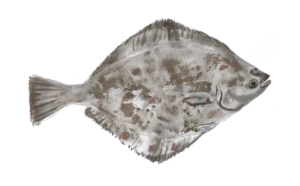The Roosterfish is considered a prized sport fish, which is any type of fish that an angler uses a rod and reel to fish for recreationally; for competition or pleasure and not commercially for profit. This fish gets its name because it has a ‘comb’ that sort of resembles a rooster’s comb. It has seven long spines that give it a large dorsal fin. The fin is what they use to maneuver its body and helps it to reach incredible speeds. When it strikes on a surface fly or lure, feels threatened, or is excited, the comb, or spines will rise in a vertical position. At other times, it will remain down.
The Roosterfish’s body had a bluish-grey hue with a silver undertone. They also have various spots on the lower part of their head, close to their eyes, and their snout. They have two slats on their sides with one that goes from the dorsal spine to the tail and the other one from the dorsal fin and extends to the fin. The dorsal fin tips are black with grey and yellow lines.
The adult Roosterfish can weigh from 75 to 80 pounds but on average, it weighs 30-40 pounds, which makes it a great sport fish. It will also raise its big dorsal fin like a flag when it is hooked and will leap around trying to unhook itself. This is one of the main reasons to consider it a sport fish. It is also considered a predator fish as it eats juvenile fish and smaller fish, along with crabs.
Where to Find a Roosterfish
You can find this fish in the warm waters of the East Pacific from Peru to Baja, California. Their main geographical area is along the coasts of Columbia, Costa Rica, Peru, Mexico, and Panama. The depth range is 15 to 60 meters. You can find them in abundance around Costa Rica. They are found in partial to shallow inshore areas, especially the sandy beach shores. You will also find them in the rocky zone. The juvenile Roosterfish are generally found in tide pools.
They are usually found about a quarter of a mile offshore. They prefer water that is eighty degrees or warmer. You can usually find them around offshore islands that have vertical walls, approximately 50-100 feet deep under the water. The most common time to see these fish are from June to September months.
How to Catch a Roosterfish
When fishing for a Roosterfish you can either:
- Surf-casting — this is done when you wade into the surf or just stand on the shoreline casting out your line using heavy-duty tackle.
- Trolling — this method of fishing is when there are one or more lines that have been baited with baitfish or lures and the lines are just drawn through the water. This can be done from a standing position onshore slowly winding in the line, behind a slowly moving boat, or when fishing from a jetty, sweeping the line side-to-side.
- Fly fish — this is best done from a boat but it is best if you are a skilled fly fisherman. This type of fishing can catch large and small Roosterfish. You can do it from the shore too. Check out Baja Flyfishing to learn more.
Best Bait for Roosterfish
If you have the right bait, you can catch a Roosterfish about a mile off the beach. Because they have a large mouth, the bait should weight between three and four pounds. Use bait such as bonito, blue runner, or mullet. They prefer live bait, as most fish do, but if you have to use dead bait, use mullet or rainbow runners. The Roosterfish is notorious for playing with the bait before it bites so you need to be patient and give it time to snag your bait.
Best Lures & Tackle for Roosterfish
The best rod to use for catching this heavy fish is a graphite composite rod that is medium to medium-heavy and is about 10-13 feet in length. You will also need a high capacity spinning well that is spooled with 300 yards of braided line. When you use this type of line, you will not spend all your time trying to fight to get the Roosterfish hauled on shore or in a boat. For the smaller Roosterfish, you can use 15 to 20-pound line but it will need to be a higher weight if you are looking to catching a larger fish. You should also have a floating line that has an intermediate sinking tip. It is recommended that you use a line that is developed for the tropics.
A popular option for lures to catch Roosterfish is surface lures, especially if you surf fish. You can try surface spoons or two-three ounce pencil poppers. Although you can see more of these Roosterfish in clear water, you can still catch them in muddy water. To do this, put some dead bait with chin weight or live bait with a circle hook. Troll it into the clear water using a surface popper to attract a fish.
Tips and Tactics
- The fish will generally feed close to the shore but will chase a live baitfish to the surface with depths of less than 200 feet.
- The best lure to use to catch them is the Canal Magic Swimmer. Just cast it out and then reel it back in at quick to medium speeds.
- If you decide to use a Bomb Popper, pump the rod while you are casting and retrieving it at medium speed. This throws a lot of white water in the air. It will excite fish to make it bite the bait.
- This heavy fish is a strong fighter and after being hooked, it can put up a fight for 40-45 minutes. Before you target this fish you need to make sure that you have your endurance built up so you can fight this fish in order to land it after that long length of time.
- To hold the bigger pieces of bait, use a fish finder rig. A fish finder rig has a barrel swivel and hook. The swivel is tied to the mainline right behind the fish finder weight slide.
- Although it might be easier to catch a Roosterfish using a boat or charter service, you can still find them close to shore so you can still fish for them. You can even catch on a kayak!
How to Cook Roosterfish
Roosterfish is not usually considered a tasty food fish but more of a challenging game fish. When you are cooking roosterfish, take the fillets and cut them into cubes and sprinkle them with pepper and salt, marinating them in lime juice for 30 minutes. Take it out of its marinate and sauté the fish in a skillet over high heat until the fish cubes are lightly browned. Then, you need to reduce the heat to medium and cook for another five minutes. When done, the flesh will be firm and flake.
Roosterfish Reproduction
The mating season for the Roosterfish is from the beginning of July until the end of February. Fertilization is external and the eggs are laid in less-depth water near the coastline. This is where the Roosterfish feels they are more protected. Until they reach maturity, the fingerlings, or babies, will settle near the surface of the water. As they grow older they will go through a series of transformations. When they are around two years old, they will migrate to the seabed
Fun Facts about a Roosterfish
- The world record for the largest Roosterfish caught was in Baja, California, and weighed 114 pounds.
- The ears of the Roosterfish are unusually arranged. Their swim bladder penetrates their brain and makes contact with the inner ear so it uses its swim bladder to amplify sounds. Their swim bladder is an internal organ that helps a fish to control their buoyancy and enables them to stay at whatever depth they are without having to expend energy swimming.
- Although it is a fish that is good to eat, most anglers use the catch and release method. They just want to be able to say they caught one and maybe have their picture taken with it before they release it back into the water.
- It has been known to chase bait for a long distance, sometimes trying to get it toward the beach or reef. They like to eat small fish like sardines or millets.
- They are a cousin to the Catfish.
Conclusion
Fishing for Roosterfish can be an enjoyable experience, especially if you have the patience, experience, and stamina to take it on. With its muscular body and large, gorgeous dorsal fin, this is a fish that is certainly worth trying to capture. The Roosterfish is one of the most sought-after predators in the fishing world and a very coveted catch. It is one of the strongest fish in the sea so that is one of the many reasons that fishermen have the Roosterfish on their list of fish they want to catch. It is an unmistakable fish and is a one-of-a-kind game fish. There are even competitions that you can enter for prizes for the largest Roosterfish caught.
As mentioned, there is an abundance of them in Costa Rica. If you have some vacation time saved up, take a trip to Costa Rica and go fishing for a Roosterfish. It will be a vacation to remember and if you manage to catch a big one, you will also have pictures and bragging rights to share with your friends and family.
Love to fish? Read our other article on How to Catch an Atlantic Cod.



